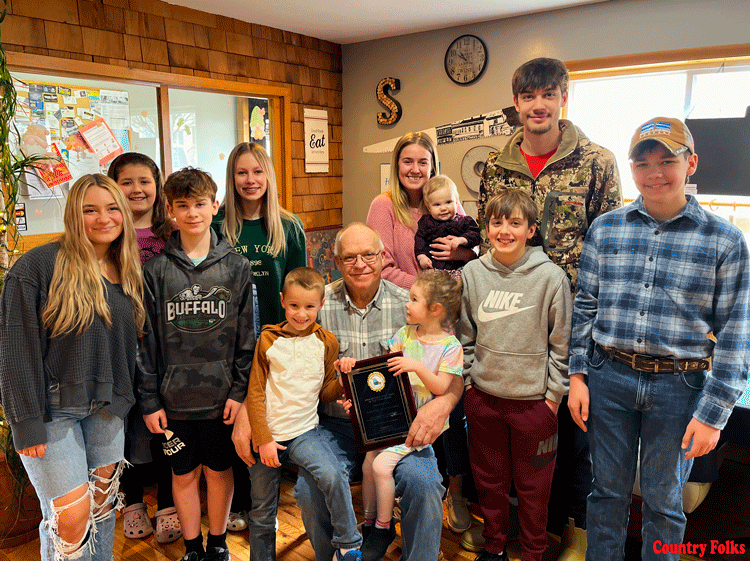 by Elizabeth A. Tomlin
by Elizabeth A. Tomlin
Cover crops should be a part of every vegetable farmer’s toolbox. That’s the message that Thomas Björkman, Associate Professor of Vegetable Crop Physiology with Cornell University explained to attendees of a vegetable grower’s meeting and workshop that took place near Fort Plain, NY.
Since vegetable production compromises soil health, which directly affects productivity, building and maintaining soil is a priority for vegetable producers.
“One management goal that is central for many vegetable farmers is maintaining good tilth, which is accomplished in part by always feeding soil microorganism with fresh organic matter,” Björkman explained. “Cover crops can provide that organic matter between vegetables.”
Cornell University Cooperative Extension’s Eastern NY Commercial Horticulture Program Regional Vegetable Specialist Crystal L. Stewart, also on hand at the workshop, says vegetable growers are becoming more aware that in order to grow vegetables long-term, it is essential to care for the soil as much as the vegetable plants. “One of the best ways to do this is to grow cover crops and return them to the soil.”
Björkman discussed a variety of cover crops including buckwheat, which he explained, is an excellent choice for New York, where many growers are bringing pasture into vegetable production. “For them, weed suppression is a top issue, as annual weeds flourish when the pasture is plowed under. Planting buckwheat at the first crop after plowing the pasture is a classic method for taming those weeds in this part of New York. Likewise, planning a buckwheat cover crop immediately after each vegetable planting finishes during July, will prevent weeds from taking over and leading to frustration next year.”
Buckwheat is also known to attract beneficial insects and assists in nitrogen scavenging and stabilizing soil aggregates.
Other soil management goals discussed included fixing nitrogen, protecting soil from rain and runoff, reducing surface crusting, breaking hardpan, suppressing soil pests and disease and increasing the biological activity of the soil.
In addition to buckwheat, cover crops recommended for New York included annual ryegrass, rye, oats, arugula, white clover, Sudangrass, hairy vetch, forage turnip/rapeseed, yellow mustard, fall mustard, medium red clover, wheat and others.
Each crop has its own beneficial attributes. For instance, annual ryegrass, which can be planted early spring through late summer — and may overwinter where there is good snow cover — will reduce weeds, stabilize soil aggregates, assist in nitrogen scavenging and protect against summer and winter erosion.
Rye, which is cold tolerant and geminates in soil 34-40 degrees F, makes an excellent choice for fall planting in the Northeast. It helps with winter erosion control, reduces weeds, stabilizes soil aggregates, increases organic matter and assists in nitrogen scavenging and winter manure application. Although rye prefers well-drained soil, it also tolerates heavy clay and acidic soil.
Medium red clover and forage turnip/rapeseed are ideal for breaking up deep compaction and reducing surface hardness, as well as having other beneficial attributes.
Forage turnips and rapeseed grow quickly, provide winter cover, suppress weeds in the following crop and decompose quickly.
Arugula and Sudangrass will both suppress nematodes.
Hairy vetch is winter hardy and praised as a late summer nitrogen-fixer that will suppress weeds and reduce surface compaction once it is established.
Björkman reports that a “decision tool” and a “New York specific” guideline is available online at www.covercrop.net to help folks decide which cover crops are best suited for their needs. Information on land preparation, seeding rates, dates and sources is also available on the site.
“Growers often use the online cover-crop decision tool while they are in the field, by connecting on their Smart Phones,” commented Björkman.
Folks unable to access that technology, may access the information from Regional Vegetable Specialist Crystal Stewart.
“In the northeast, finding cover crops that fit into the vegetable rotation can be challenging,” said Stewart. “If a grower only plants cover crops after the vegetables are done in the fall, he or she is limited to a small handful of options.”
Stewart says if a grower dedicates only 30-50 percent of total vegetable cropland to cover crops each year, “it is possible to accomplish amazing things!”
“We often see that growers who are willing to grow vegetables more intensively in a smaller space so they can plant cover crops during the growing season are able to maintain yield and profitability while improving their soil,” said Stewart. “It’s an upward spiral.”
Managing Cover Crops Profitably, a publication by Northeast Sustainable Agriculture Research and Education Program, is available to vegetable growers upon request.
“New York vegetable growers have a great advantage in having ready access to that expertise, whether they have been in business for generations or just began farming last year,” Björkman stated.
For more information contact Crystal Stewart at cls263@cornell.edu or 518-775-0018.











Leave A Comment